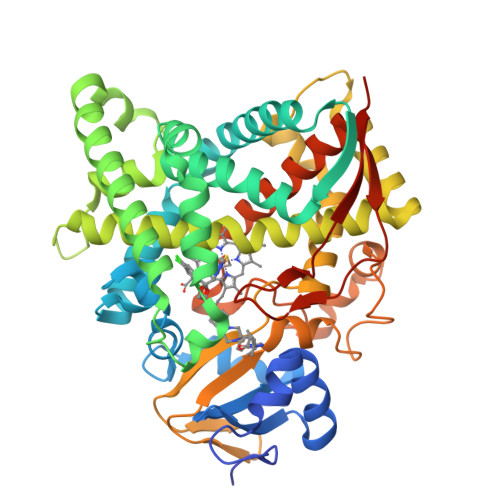CYP51 is an essential drug target for the treatment of primary amoebic meningoencephalitis (PAM).
Debnath, A., Calvet, C.M., Jennings, G., Zhou, W., Aksenov, A., Luth, M.R., Abagyan, R., Nes, W.D., McKerrow, J.H., Podust, L.M.(2017) PLoS Negl Trop Dis 11: e0006104-e0006104
- PubMed: 29284029
- DOI: https://doi.org/10.1371/journal.pntd.0006104
- Primary Citation of Related Structures:
6AY4, 6AY6, 6AYB, 6AYC - PubMed Abstract:
Primary Amoebic Meningoencephalitis (PAM) is caused by Naegleria fowleri, a free-living amoeba that occasionally infects humans. While considered "rare" (but likely underreported) the high mortality rate and lack of established success in treatment makes PAM a particularly devastating infection. In the absence of economic inducements to invest in development of anti-PAM drugs by the pharmaceutical industry, anti-PAM drug discovery largely relies on drug 'repurposing'-a cost effective strategy to apply known drugs for treatment of rare or neglected diseases. Similar to fungi, N. fowleri has an essential requirement for ergosterol, a building block of plasma and cell membranes. Disruption of sterol biosynthesis by small-molecule inhibitors is a validated interventional strategy against fungal pathogens of medical and agricultural importance. The N. fowleri genome encodes the sterol 14-demethylase (CYP51) target sharing ~35% sequence identity to fungal orthologues. The similarity of targets raises the possibility of repurposing anti-mycotic drugs and optimization of their usage for the treatment of PAM. In this work, we (i) systematically assessed the impact of anti-fungal azole drugs, known as conazoles, on sterol biosynthesis and viability of cultured N. fowleri trophozotes, (ii) identified the endogenous CYP51 substrate by mass spectrometry analysis of N. fowleri lipids, and (iii) analyzed the interactions between the recombinant CYP51 target and conazoles by UV-vis spectroscopy and x-ray crystallography. Collectively, the target-based and parasite-based data obtained in these studies validated CYP51 as a potentially 'druggable' target in N. fowleri, and conazole drugs as the candidates for assessment in the animal model of PAM.
Organizational Affiliation:
Center for Discovery and Innovation in Parasitic Diseases, Skaggs School of Pharmacy and Pharmaceutical Sciences, University of California San Diego, La Jolla, California, United States of America.


















